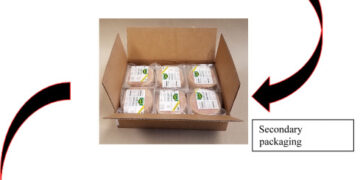The world is facing significant environmental challenges, including pollution, climate change, and biodiversity loss. As a result, individuals and organizations are increasingly taking steps to reduce their environmental impact. One area where businesses can make a significant impact is by adopting eco-friendly packaging materials.
Eco-friendly packaging materials are those that are designed to have minimal impact on the environment throughout their lifecycle, from production to disposal. There are several benefits to using these materials in your business, including:
Reduced Environmental Impact
The most significant benefit of eco-friendly packaging materials is that they have a reduced environmental impact. Conventional packaging materials such as plastic and Styrofoam can take hundreds of years to break down, polluting the environment in the process. In contrast, eco-friendly materials such as paper, cardboard, and biodegradable plastics are designed to decompose quickly, minimizing their impact on the environment.
Eco-friendly packaging materials also typically require less energy and resources to produce than conventional materials. For example, producing recycled paper uses 60% less energy than producing new paper. By using eco-friendly materials, your business can reduce its carbon footprint and minimize its impact on the environment.
Improved Brand Image
Adopting eco-friendly packaging materials can also improve your brand image. Consumers are increasingly concerned about the environment and are looking for businesses that prioritize sustainability. By using eco-friendly materials, you demonstrate your commitment to sustainability and can attract environmentally-conscious consumers.

In addition to attracting new customers, using eco-friendly packaging materials can also improve customer loyalty. Studies have shown that consumers are more likely to purchase from businesses that prioritize sustainability, and are more likely to remain loyal to those businesses over time.
Cost Savings
Contrary to popular belief, using eco-friendly packaging materials can actually save your business money in the long run. While eco-friendly materials may be more expensive upfront, they often have a longer lifespan and require less frequent replacement than conventional materials.
For example, a reusable tote bag made from eco-friendly materials may cost more than a single-use plastic bag, but it can be used hundreds of times, reducing the overall cost per use. Additionally, some eco-friendly materials such as recycled paper and cardboard may be cheaper than their conventional counterparts, depending on the specific application.
Compliance with Regulations
Many countries and jurisdictions have regulations in place that require businesses to use eco-friendly packaging materials. For example, the European Union has banned single-use plastics such as straws, cutlery, and plates. Other countries have introduced taxes or fees on plastic bags to discourage their use.
By using eco-friendly packaging materials, your business can comply with these regulations and avoid potential fines or penalties. Additionally, adopting eco-friendly materials before regulations are introduced can give your business a competitive advantage over others that may be slower to adapt.
Increased Innovation and Creativity
Adopting eco-friendly packaging materials can also lead to increased innovation and creativity within your business. By prioritizing sustainability, you may need to rethink your entire packaging strategy, leading to new and innovative solutions.
For example, a business that traditionally used plastic packaging may switch to biodegradable packaging made from plant-based materials. This switch could lead to new opportunities for collaboration with suppliers, designers, and other stakeholders, and could result in new and innovative packaging solutions that differentiate your business from competitors.
- Biodegradable plastics: These are plastics that are designed to break down quickly in the environment, reducing their impact on ecosystems. They are typically made from plant-based materials such as cornstarch or sugarcane, rather than petroleum-based materials.
- Recycled paper and cardboard: These materials are made from post-consumer waste, reducing the need for virgin materials and conserving resources. They can be used for a wide range of applications, from shipping boxes to product packaging.
- Plant-based materials: These materials are made from renewable resources such as bamboo, hemp, or bagasse (a by product of sugarcane processing). They can be used to create a variety of packaging products, including plates, bowls, and cutlery.
- Reusable containers: Rather than using single-use packaging, businesses can consider reusable containers made from durable materials such as glass or metal. These containers can be used multiple times, reducing waste and conserving resources.

When considering eco-friendly packaging materials, it’s important to consider the entire lifecycle of the product, from production to disposal. This includes factors such as the energy required to produce the material, the transportation required to transport it, and the end-of-life options (such as composting or recycling).
It’s also important to communicate your commitment to sustainability to consumers. This can be done through labelling and marketing materials, as well as through education and outreach efforts. By highlighting your use of eco-friendly packaging materials, you can differentiate your business and attract environmentally-conscious consumers.
Moreover, businesses can also consider implementing other sustainable practices alongside the adoption of eco-friendly packaging materials. For instance, reducing the overall amount of packaging used or optimizing the design of packaging to minimize waste can further reduce the environmental impact of your business.
Additionally, businesses can also explore options to reduce the carbon footprint of their shipping operations. This includes using renewable energy sources, optimizing delivery routes to reduce emissions, and partnering with shipping companies that prioritize sustainability.
Furthermore, businesses can also consider implementing recycling and composting programs within their operations. This can help divert waste from landfills and reduce the overall environmental impact of the business.
Overall, the benefits of using eco-friendly packaging materials extend beyond environmental concerns. Adopting these materials can also lead to cost savings, compliance with regulations, increased innovation, and improved brand image. By prioritizing sustainability in your packaging strategy, you can demonstrate your commitment to environmental responsibility and attract environmentally-conscious consumers.
Conclusion
Adopting eco-friendly packaging materials can have significant benefits for your business, including reduced environmental impact, improved brand image, cost savings, compliance with regulations, and increased innovation and creativity. While there may be some upfront costs associated with the transition to eco-friendly materials, the long-term benefits are clear. By prioritizing sustainability in your packaging strategy, you can attract environmentally-conscious consumers, comply with regulations, and differentiate your business from competitors.















